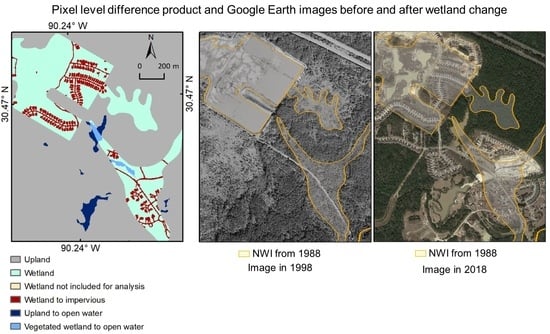Use of High-Resolution Land Cover Maps to Support the Maintenance of the NWI Geospatial Dataset: A Case Study in a Coastal New Orleans Region
Abstract
:1. Introduction
2. Materials and Methods
2.1. Study Area
2.2. Data
2.2.1. NWI
2.2.2. C-CAP 1 m Dataset
2.2.3. Time Series Inundation Data
2.3. Methods
2.3.1. Derivation and Validation of the Pixel Level Difference Product
2.3.2. Calculation of New Attributes for NWI Wetland Polygons
2.3.3. Delineation of New Water Body Polygons
2.3.4. Calculation of Difference Statistics at the Watershed Scale
3. Results
3.1. Pixel Level Differences and Wetland Change
3.2. New Attributes for NWI Wetland Polygons
3.3. C-CAP-Based Water Body Polygons
3.4. Spatially Aggregated Difference
4. Discussion
5. Conclusions
Author Contributions
Funding
Data Availability Statement
Acknowledgments
Conflicts of Interest
References
- Mitsch, W.J.; Bernal, B.; Hernandez, M.E. Ecosystem Services of Wetlands. Int. J. Biodivers. Sci. Ecosyst. Serv. Manag. 2015, 11, 1–4. [Google Scholar] [CrossRef]
- Murray, N.J. The Extent and Drivers of Global Wetland Loss. Nature 2023, 614, 234–235. [Google Scholar] [CrossRef] [PubMed]
- Galatowitsch, S.M. Natural and Anthropogenic Drivers of Wetland Change. In The Wetland Book Ii: Distribution, Description, and Conservation; Springer Nature: London, UK, 2018; pp. 359–367. [Google Scholar]
- Senanayake, I.P.; Yeo, I.Y.; Kuczera, G.A. A Random Forest-Based Multi-Index Classification (Rafmic) Approach to Mapping Three-Decadal Inundation Dynamics in Dryland Wetlands Using Google Earth Engine. Remote Sens. 2023, 15, 1263. [Google Scholar] [CrossRef]
- Sudol, T.A.; Noe, G.B.; Reed, D.J. Tidal Wetland Resilience to Increased Rates of Sea Level Rise in the Chesapeake Bay: Introduction to the Special Feature. Wetlands 2020, 40, 1667–1671. [Google Scholar] [CrossRef]
- Russell, M.T.; Cartwright, J.M.; Collins, G.H.; Long, R.A.; Eitel, J.H. Legacy Effects of Hydrologic Alteration in Playa Wetland Responses to Droughts. Wetlands 2020, 40, 2011–2024. [Google Scholar] [CrossRef]
- Johnson, W.C.; Poiani, K.A. Climate Change Effects on Prairie Pothole Wetlands: Findings from a Twenty-Five Year Numerical Modeling Project. Wetlands 2016, 36, 273–285. [Google Scholar] [CrossRef]
- Jamal, S.; Ahmad, W.S. Assessing Land Use Land Cover Dynamics of Wetland Ecosystems Using Landsat Satellite Data. SN Appl. Sci. 2020, 2, 1891. [Google Scholar] [CrossRef]
- Wang, Y.; Molinos, J.G.; Shi, L.; Zhang, M.; Wu, Z.; Zhang, H.; Xu, J. Drivers and Changes of the Poyang Lake Wetland Ecosystem. Wetlands 2019, 39, 35–44. [Google Scholar] [CrossRef]
- Gibbs, J.P. Wetland Loss and Biodiversity Conservation. Conserv. Biol. 2000, 14, 314–317. [Google Scholar] [CrossRef]
- Matthews, J.W.; Skultety, D.; Zercher, B.; Ward, M.P.; Benson, T.J. Field Verification of Original and Updated National Wetlands Inventory Maps in Three Metropolitan Areas in Illinois, USA. Wetlands 2016, 36, 1155–1165. [Google Scholar] [CrossRef]
- Dahl, T.; Bergeson, M. Technical Procedures for Conducting Status and Trends of the Nation’s Wetlands; U.S. Department of the Interior, U.S. Fish and Wildlife Service: Washington, DC, USA, 2017. Available online: https://www.fws.gov/wetlands/documents/Technical-Procedures-for-Conducting-Status-and-Trends-of-the-Nations-Wetlands.pdf (accessed on 10 December 2022).
- Hu, S.; Niu, Z.; Chen, Y. Global Wetland Datasets: A Review. Wetlands 2017, 37, 807–817. [Google Scholar] [CrossRef]
- Federal Geographic Data Committee. Classification of Wetlands and Deepwater Habitats of the United States; Federal Geographic Data Committee and U.S. Fish and Wildlife Service: Washington, DC, USA, 2013. Available online: https://www.fws.gov/sites/default/files/documents/Classification-of-Wetlands-and-Deepwater-Habitats-of-the-United-States-2013.pdf (accessed on 20 September 2020).
- Holland, C.C.; Honea, J.E.; Gwin, S.E.; Kentula, M.E. Wetland Degradation and Loss in the Rapidly Urbanizing Area of Portland, Oregon. Wetlands 1995, 15, 336–345. [Google Scholar] [CrossRef]
- Kentula, M.E.; Gwin, S.E.; Pierson, S.M. Tracking Changes in Wetlands with Urbanization: Sixteen Years of Experience in Portland, Oregon, USA. Wetlands 2004, 24, 734–743. [Google Scholar] [CrossRef]
- Houhoulis, P.F.; Michener, W.K. Detecting Wetland Change: A Rule-Based Approach Using Nwi and Spot-Xs Data. Photogramm. Eng. Remote Sens. 2000, 66, 205–211. [Google Scholar]
- Dobson, J.E. Noaa Coastal Change Analysis Program (C-Cap): Guidance for Regional Implementation. 1995. Available online: https://spo.nmfs.noaa.gov/Technical%20Report/tr123.pdf (accessed on 10 August 2023).
- Nielsen, E.M.; Prince, S.D.; Koeln, G.T. Wetland Change Mapping for the Us Mid-Atlantic Region Using an Outlier Detection Technique. Remote Sens. Environ. 2008, 112, 4061–4074. [Google Scholar] [CrossRef]
- Xu, H.Q.; Toman, E.M.; Zhao, K.G.; Baird, J. Fusion of Lidar and Aerial Imagery to Map Wetlands and Channels Via Deep Convolutional Neural Network. Transp. Res. Rec. 2022, 2676, 374–381. [Google Scholar] [CrossRef]
- Stein, B.R.; Zheng, B.J.J.; Kikkinidis, I.; Kayastha, N.; Seigler, T.; Gokkaya, K.; Gopalakrishnan, R.; Hwang, W.H. An Efficient Remote Sensing Solution to Update the Ncwi. Photogramm. Eng. Remote Sens. 2012, 78, 537–547. [Google Scholar]
- Wu, Q.S.; Lane, C.R.; Li, X.C.; Zhao, K.G.; Zhou, Y.Y.; Clinton, N.; DeVries, B.; Golden, H.E.; Lang, M.W. Integrating Lidar Data and Multi-Temporal Aerial Imagery to Map Wetland Inundation Dynamics Using Google Earth Engine. Remote Sens. Environ. 2019, 228, 1–13. [Google Scholar] [CrossRef]
- Du, L.; McCarty, G.W.; Zhang, X.; Lang, M.W.; Vanderhoof, M.K.; Li, X.; Huang, C.; Lee, S.; Zou, Z. Mapping Forested Wetland Inundation in the Delmarva Peninsula, USA Using Deep Convolutional Neural Networks. Remote Sens. 2020, 12, 644. [Google Scholar] [CrossRef]
- Whitcomb, J.; Moghaddam, M.; McDonald, K.; Kellndorfer, J.; Podest, E. Mapping Vegetated Wetlands of Alaska Using L-Band Radar Satellite Imagery. Can. J. Remote Sens. 2009, 35, 54–72. [Google Scholar] [CrossRef]
- Stubbs, Q.; Yeo, I.Y.; Lang, M.G.; Townshend, J.; Sun, L.X.; Prestegaard, K.; Jantz, C. Assessment of Wetland Change on the Delmarva Peninsula from 1984 to 2010. J. Coastal. Res. 2020, 36, 575–589. [Google Scholar] [CrossRef]
- NOAA. High Resolution Land Cover Data. Coastal Change Analysis Program (C-Cap) High-Resolution Land Cover; Noaa Office for Coastal Management: Charleston, SC, USA, 2022. Available online: https://chs.coast.noaa.gov/htdata/raster1/landcover/bulkdownload/hires/la/ (accessed on 5 January 2022).
- Barbier, E.B.; Georgiou, I.Y.; Enchelmeyer, B.; Reed, D.J. The Value of Wetlands in Protecting Southeast Louisiana from Hurricane Storm Surges. PLoS ONE 2013, 8, e58715. [Google Scholar] [CrossRef] [PubMed]
- Jankowski, K.L.; Tornqvist, T.E.; Fernandes, A.M. Vulnerability of Louisiana’s Coastal Wetlands to Present-Day Rates of Relative Sea-Level Rise. Nat. Commun. 2017, 8, 14792. [Google Scholar] [CrossRef] [PubMed]
- Lane, R.R.; Day, J.W.; Day, J.N. Wetland Surface Elevation, Vertical Accretion, and Subsidence at Three Louisiana Estuaries Receiving Diverted Mississippi River Water. Wetlands 2006, 26, 1130–1142. [Google Scholar] [CrossRef]
- Ehrenfeld, J.G. Evaluating Wetlands within an Urban Context. Ecol. Eng. 2000, 15, 253–265. [Google Scholar] [CrossRef]
- Mossa, J.; Marks, S.R. Pit Avulsions and Planform Change on a Mined River Floodplain: Tangipahoa River, Louisiana. Phys. Geogr. 2011, 32, 512–532. [Google Scholar] [CrossRef]
- Cowardin, L.M.; Carter, V.; Golet, F.C.; LaRoe, E.T. Classification of Wetlands and Deepwater Habitats of the United States, 1st ed.; US Department of the Interior, US Fish and Wildlife Service: Washington, DC, USA, 1979; pp. 21–24.
- U.S. Fish and Wildlife Service. National Wetland Inventory. 2021. Available online: https://fwsprimary.wim.usgs.gov/wetlands/apps/wetlands-mapper/ (accessed on 20 July 2021).
- Jones, J.W. Efficient Wetland Surface Water Detection and Monitoring Via Landsat: Comparison with in Situ Data from the Everglades Depth Estimation Network. Remote Sens. 2015, 7, 12503–12538. [Google Scholar] [CrossRef]
- Jones, J.W. Improved Automated Detection of Subpixel-Scale Inundationrevised Dynamic Surface Water Extent (Dswe) Partial Surface Water Tests. Remote Sens. 2019, 11, 374. [Google Scholar] [CrossRef]
- Gorelick, N.; Hancher, M.; Dixon, M.; Ilyushchenko, S.; Thau, D.; Moore, R. Google Earth Engine: Planetary-Scale Geospatial Analysis for Everyone. Remote Sens. Environ. 2017, 202, 18–27. [Google Scholar] [CrossRef]
- McKinney, M.L. Urbanization, Biodiversity, and Conservation. Bioscience 2002, 52, 883–890. [Google Scholar] [CrossRef]
- Wickham, J.; Stehman, S.V.; Sorenson, D.G.; Gass, L.; Dewitz, J.A. Thematic Accuracy Assessment of the Nlcd 2016 Land Cover for the Conterminous United States. Remote Sens. Environ. 2021, 257, 112357. [Google Scholar] [CrossRef]
- NOAA. C-Cap Land Cover Files for 10 m Land Cover. 2017. Available online: https://coast.noaa.gov/htdata/raster1/landcover/bulkdownload/Beta/10m_LC/ (accessed on 3 November 2022).
- Wang, X.G.; Yan, F.Q.; Su, F.Z. Impacts of Urbanization on the Ecosystem Services in the Guangdong-Hong Kong-Macao Greater Bay Area, China. Remote Sens. 2020, 12, 3269. [Google Scholar] [CrossRef]
- Zou, Z.; Xiao, X.; Dong, J.; Qin, Y.; Doughty, R.B.; Menarguez, M.A.; Zhang, G.; Wang, J. Divergent Trends of Open-Surface Water Body Area in the Contiguous United States from 1984 to 2016. Proc. Natl. Acad. Sci. USA 2018, 115, 3810–3815. [Google Scholar] [CrossRef] [PubMed]
- Skovira, L.M.; Bohlen, P.J. Water Quality, Vegetation, and Management of Stormwater Ponds Draining Three Distinct Urban Land Uses in Central Florida. Urban Ecosyst. 2023, 26, 867–879. [Google Scholar] [CrossRef]


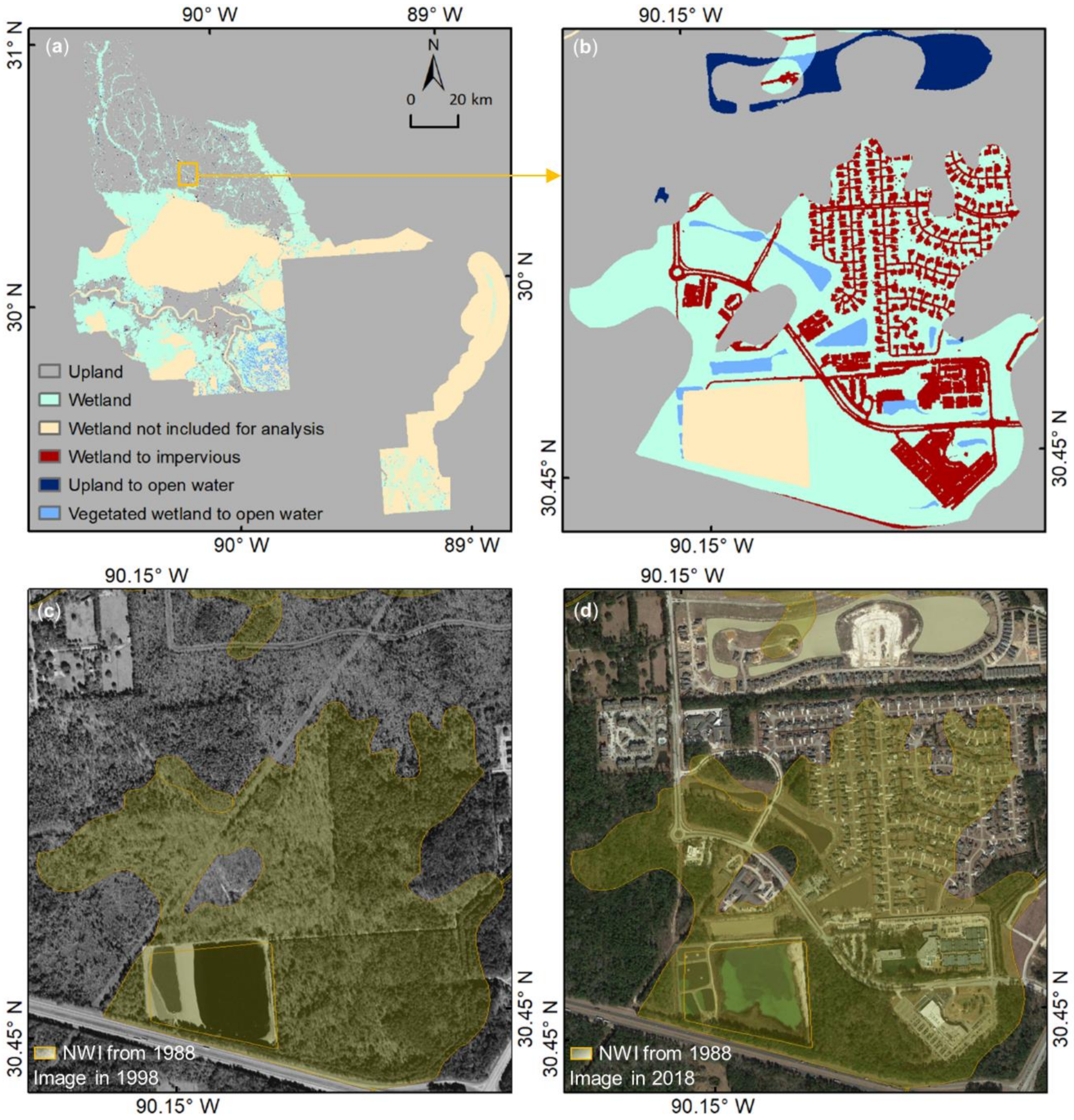
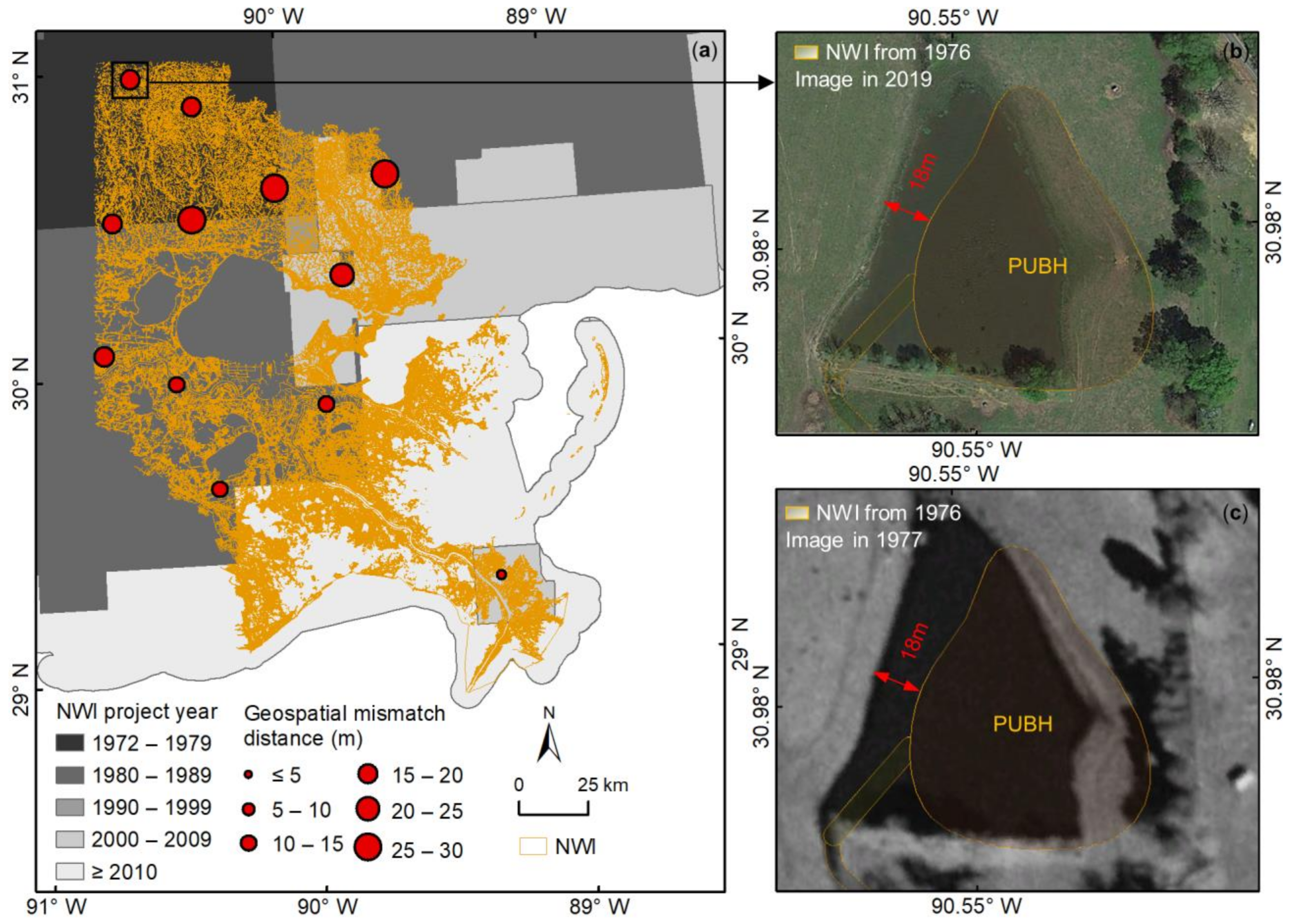
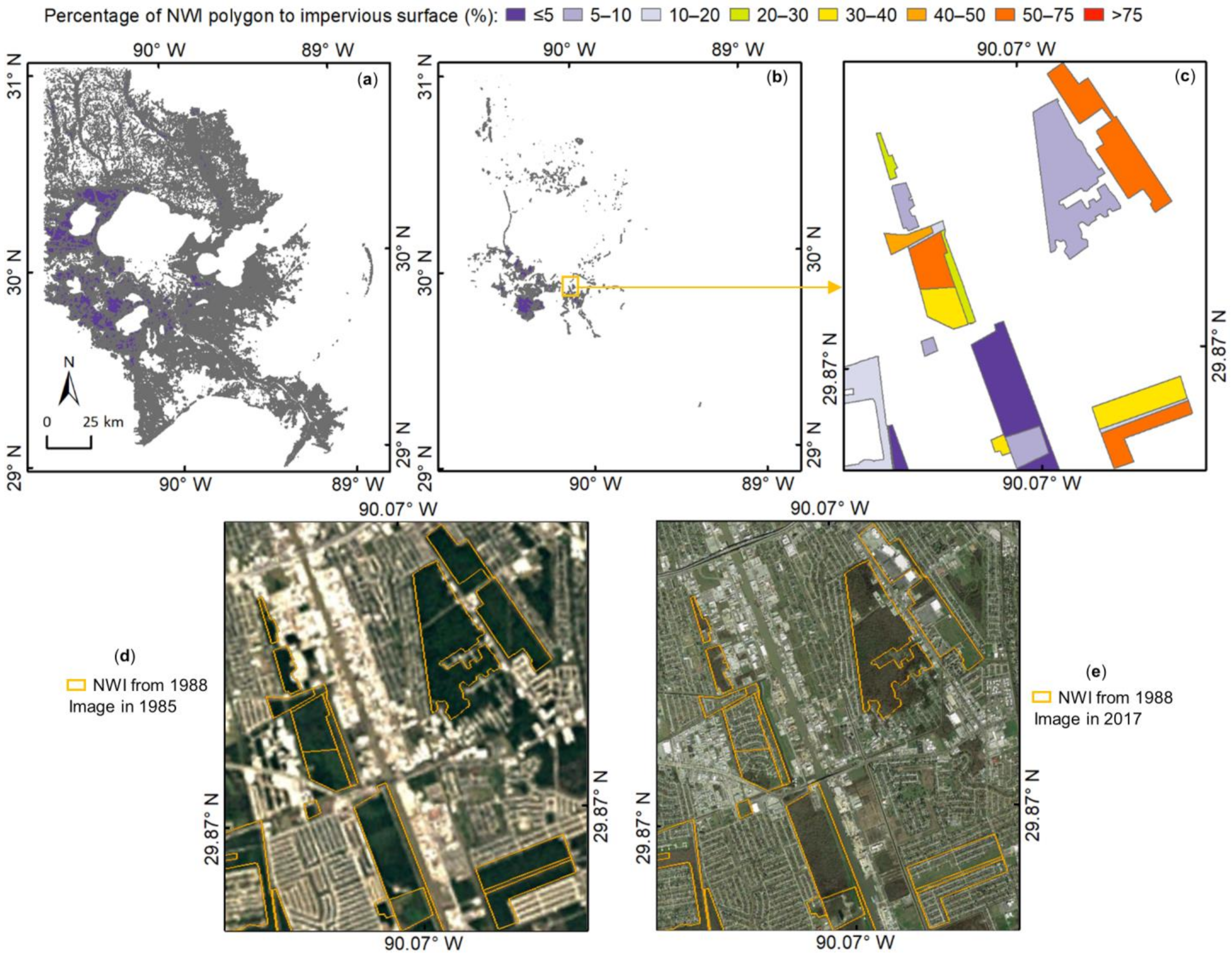
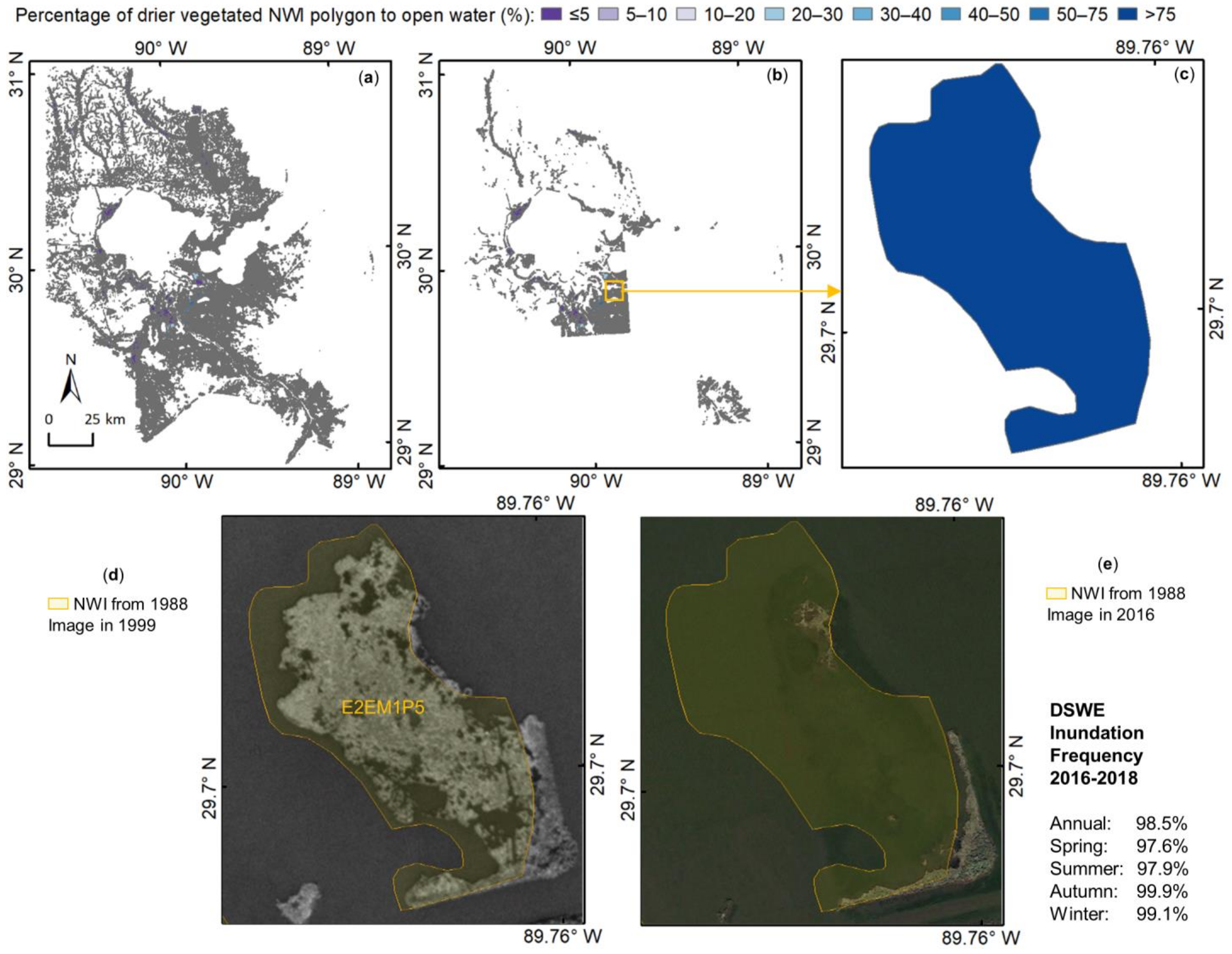
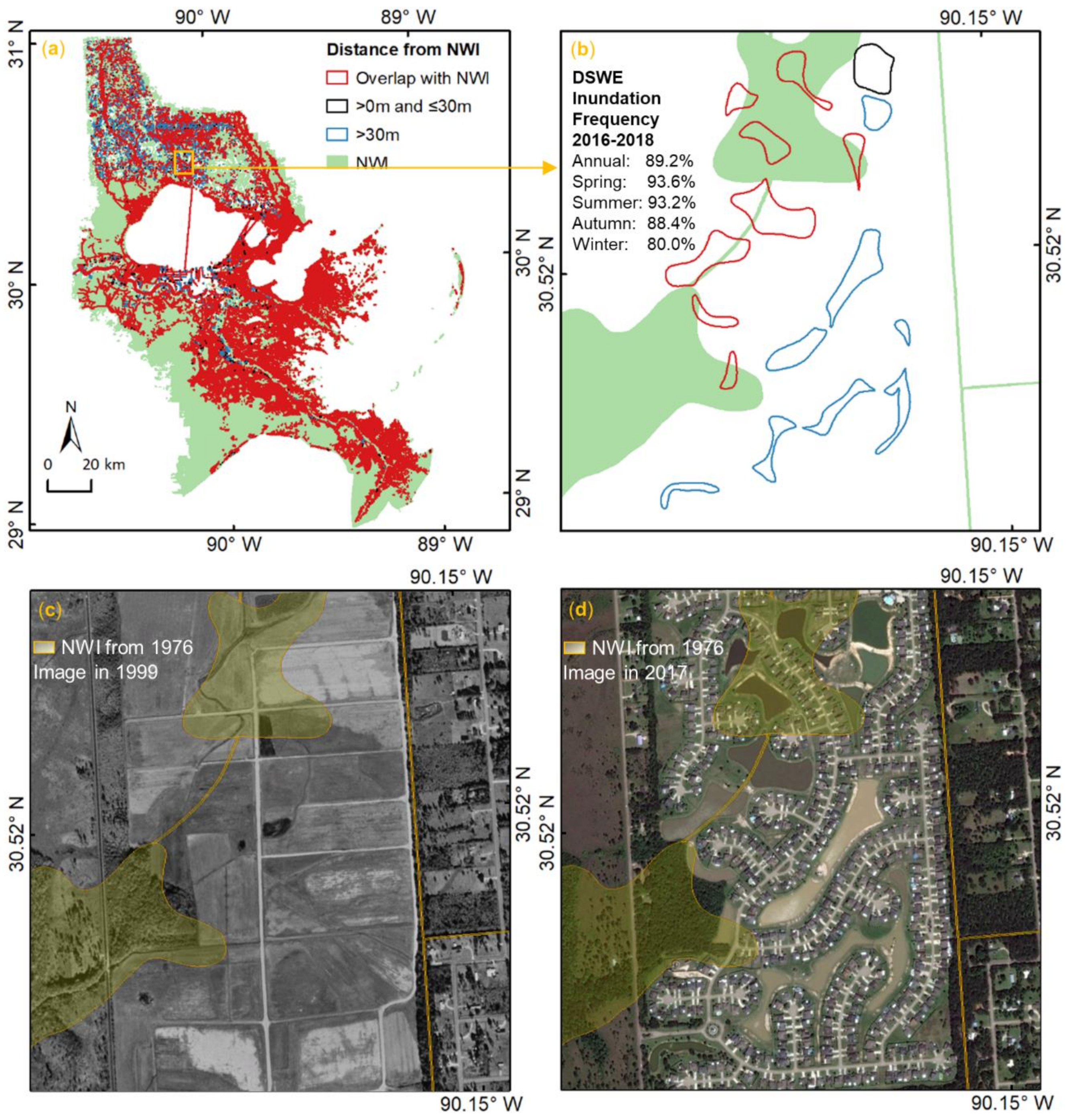
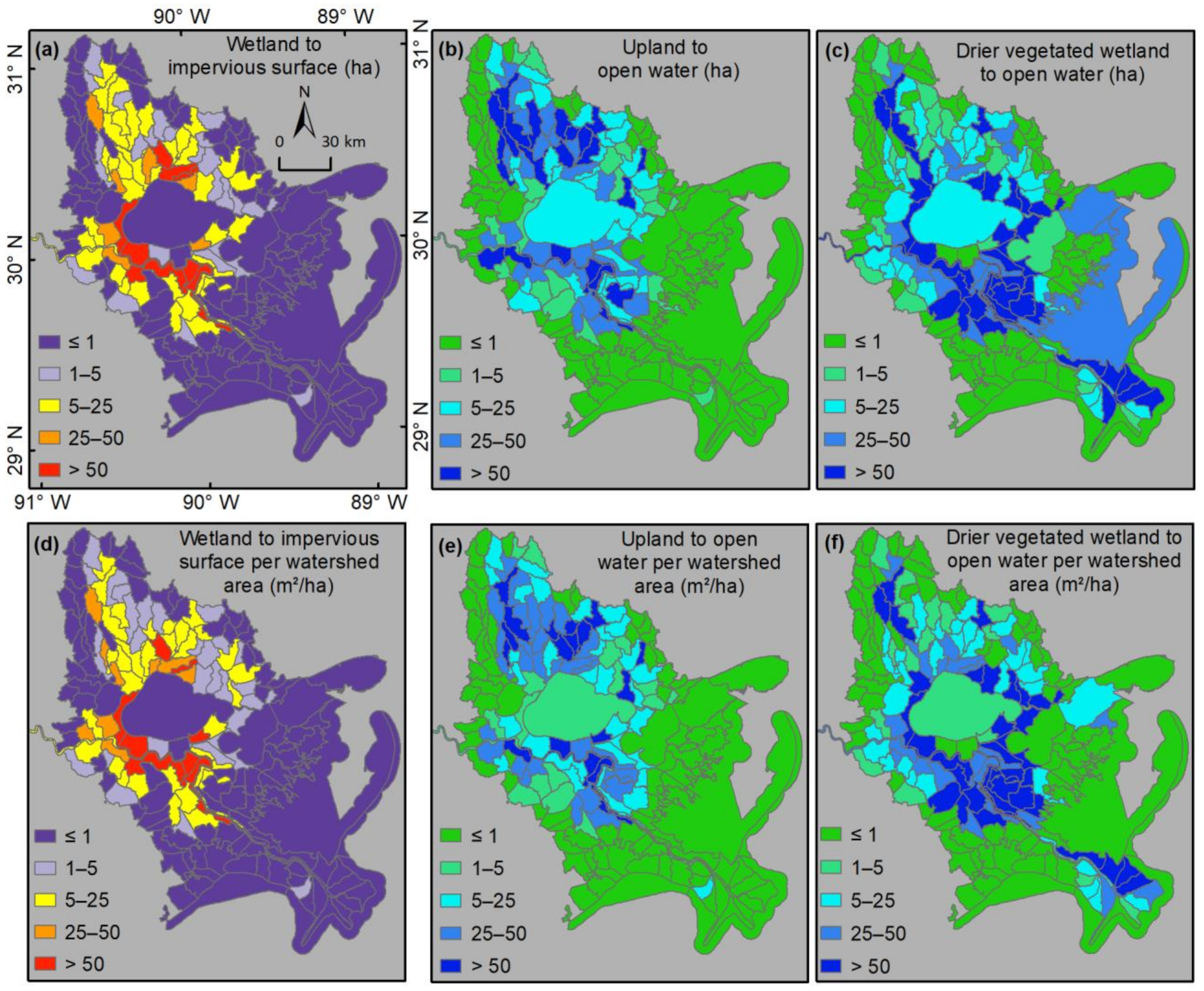
| Nontidal | Saltwater Tidal | Freshwater Tidal | |||
|---|---|---|---|---|---|
| Code | Name | Code | Name | Code | Name |
| A | Temporarily Flooded | L | Subtidal | Q | Regularly Flooded–Fresh Tidal |
| B | Seasonally Saturated | M | Irregularly Exposed | R | Seasonally Flooded–Fresh Tidal |
| C | Seasonally Flooded | N | Regularly Flooded | S | Temporarily Flooded–Fresh Tidal |
| D | Continuously Saturated | P | Irregularly Flooded | T | Semi-Permanently Flooded–Fresh Tidal |
| E | Seasonally Flooded/Saturated | V | Permanently Flooded–Fresh Tidal | ||
| F | Semi-Permanently Flooded | ||||
| G | Intermittently Exposed | ||||
| H | Permanently Flooded | ||||
| J | Intermittently Flooded | ||||
| K | Artificially Flooded | ||||
| Reference Data | ||||
|---|---|---|---|---|
| Wetland to Impervious (Reference) | Wetland Not Changed to Impervious (Reference) | Total | User Accuracy | |
| Wetland to impervious (map) | 185 | 15 | 200 | 0.925 |
| Wetland not changed to impervious (map) | 0 | 200 | 200 | 1.000 |
| Total | 185 | 215 | 400 | Overall Accuracy |
| Producer accuracy | 1.000 | 0.930 | 0.963 | |
| Upland to Open Water (Reference) | Upland Not Changed to Water (Reference) | Total | User Accuracy | |
|---|---|---|---|---|
| Upland to Open water (map) | 197 | 3 | 200 | 0.985 |
| Upland not changed to water (map) | 1 | 199 | 200 | 0.995 |
| Total | 198 | 202 | 400 | Overall Accuracy |
| Producer accuracy | 0.995 | 0.985 | 0.990 |
| Drier Vegetated Wetland to Open Water (Reference) | Drier Vegetated Wetland Not Changed to Open Water (Reference) | Total | User Accuracy | |
|---|---|---|---|---|
| Driver vegetated wetland to open water (map) | 189 | 11 | 200 | 0.945 |
| Driver vegetated wetland not changed to open water (map) | 15 | 185 | 200 | 0.925 |
| Total | 204 | 196 | 400 | Overall Accuracy |
| Producer accuracy | 0.926 | 0.944 | 0.935 |
Disclaimer/Publisher’s Note: The statements, opinions and data contained in all publications are solely those of the individual author(s) and contributor(s) and not of MDPI and/or the editor(s). MDPI and/or the editor(s) disclaim responsibility for any injury to people or property resulting from any ideas, methods, instructions or products referred to in the content. |
© 2023 by the authors. Licensee MDPI, Basel, Switzerland. This article is an open access article distributed under the terms and conditions of the Creative Commons Attribution (CC BY) license (https://creativecommons.org/licenses/by/4.0/).
Share and Cite
Zou, Z.; Huang, C.; Lang, M.W.; Du, L.; McCarty, G.; Ingebritsen, J.C.; Herold, N.; Griffin, R.; Gong, W.; Lu, J. Use of High-Resolution Land Cover Maps to Support the Maintenance of the NWI Geospatial Dataset: A Case Study in a Coastal New Orleans Region. Remote Sens. 2023, 15, 4075. https://doi.org/10.3390/rs15164075
Zou Z, Huang C, Lang MW, Du L, McCarty G, Ingebritsen JC, Herold N, Griffin R, Gong W, Lu J. Use of High-Resolution Land Cover Maps to Support the Maintenance of the NWI Geospatial Dataset: A Case Study in a Coastal New Orleans Region. Remote Sensing. 2023; 15(16):4075. https://doi.org/10.3390/rs15164075
Chicago/Turabian StyleZou, Zhenhua, Chengquan Huang, Megan W. Lang, Ling Du, Greg McCarty, Jeffrey C. Ingebritsen, Nate Herold, Rusty Griffin, Weishu Gong, and Jiaming Lu. 2023. "Use of High-Resolution Land Cover Maps to Support the Maintenance of the NWI Geospatial Dataset: A Case Study in a Coastal New Orleans Region" Remote Sensing 15, no. 16: 4075. https://doi.org/10.3390/rs15164075
APA StyleZou, Z., Huang, C., Lang, M. W., Du, L., McCarty, G., Ingebritsen, J. C., Herold, N., Griffin, R., Gong, W., & Lu, J. (2023). Use of High-Resolution Land Cover Maps to Support the Maintenance of the NWI Geospatial Dataset: A Case Study in a Coastal New Orleans Region. Remote Sensing, 15(16), 4075. https://doi.org/10.3390/rs15164075







